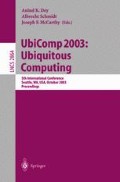Abstract
One of the principal requirements of ubiquitous computing is support for spontaneous interoperation, in which two or more devices interact temporarily in ad hoc circumstances. Spontaneity typically arises when nomadic users carry one or more of the devices around. We contribute a method of using lasers for securing spontaneous device associations. The method provides users with physical evidence of which device they have connected their device to, as well as setting up a secure channel between the devices.
Access this chapter
Tax calculation will be finalised at checkout
Purchases are for personal use only
Preview
Unable to display preview. Download preview PDF.
References
Kindberg, T., Fox, A.: System Software for Ubiquitous Computing. IEEE Pervasive Computing 1(1), 70–81 (2002)
Kindberg, T., Zhang, K., Shankar, N.: Context authentication using constrained channels. In: 4th IEEE Workshop on Mobile Computing Systems & Applications (WMCSA) (June 2002)
Czerwinski, S., Zhao, B., Hodes, T., Joseph, A., Katz, R.: An Architecture for a Secure Service Discovery Service. In: Proc. fifth annual ACM/IEEE international conference on Mobile computing and networking, pp. 24–35 (1999)
Stajano, F., Anderson, R.: The Resurrecting Duckling: Security Issues for Ad-hoc Wireless Networks. In: Christianson, B., Crispo, B., Roe, M. (eds.) Security Protocols. Proc. 7th International Workshop Proc. Springer, Heidelberg (1999)
Holmquist, L.E., Mattern, F., Schiele, B., Alahuhta, P., Beigl, M., Gellersen, H.-W.: Smart-Its Friends: A Technique for Users to Easily Establish Connections between Smart Artefacts. In: Abowd, G.D., Brumitt, B., Shafer, S. (eds.) UbiComp 2001. LNCS, vol. 2201, pp. 273–291. Springer, Heidelberg (2001)
Feeney, L., Ahlgren, B., Westerlund, A.: Spontaneous Networking: An Applicationoriented Approach to Ad Hoc Networking. IEEE Communications Magazine 39(6) (2001)
Balfanz, D., Smetters, D.K., Stewart, P., Wong, H.C.: Talking to strangers: authentication in ad-hoc wireless networks. In: Network and Distributed System Security Symposium, San Diego, CA, USA, February 6-8 (2002)
Shared Wireless Access Protocol (Cordless Access) Specification (SWAP-CA), Revision 1.0, The HomeRF Technical Committee, December 17 (1998)
Iwasaki, Y., Kawaguchi, N., Inagaki, Y.: Touch-and-Connect: A Connection Request Framework for Ad-hoc Networks and the Pervasive Computing Environment. In: Proc. IEEE PerCom, pp. 20–29 (2003)
Addlesee, M., Curwen, R., Hodges, S., Newman, J., Steggles, P., Ward, A., Hopper, A.: Implementing a sentient computing system. IEEE Computer 34(8), 50–56 (2001)
Kindberg, T., Zhang, K.: Validating and Securing Spontaneous Associations between Wireless Devices. In: Boyd, C., Mao, W. (eds.) ISC 2003. LNCS, vol. 2851, pp. 44–53. Springer, Heidelberg (2003) (to appear)
Ringwald, M.: Spontaneous Interaction with Everyday Devices Using a PDA. In: Proc. Supporting Spontaneous Interaction in Ubiquitous Computing Settings, a workshop held at Ubicomp (2002), http://www.dcs.gla.ac.uk/p/~d/Workshops/papers/ringwald.pdf
Beigl, M.: Point & Click - Interaction in Smart Environments. In: Gellersen, H.-W. (ed.) HUC 1999. LNCS, vol. 1707, pp. 311–314. Springer, Heidelberg (1999)
Author information
Authors and Affiliations
Editor information
Editors and Affiliations
Rights and permissions
Copyright information
© 2003 Springer-Verlag Berlin Heidelberg
About this paper
Cite this paper
Kindberg, T., Zhang, K. (2003). Secure Spontaneous Device Association. In: Dey, A.K., Schmidt, A., McCarthy, J.F. (eds) UbiComp 2003: Ubiquitous Computing. UbiComp 2003. Lecture Notes in Computer Science, vol 2864. Springer, Berlin, Heidelberg. https://doi.org/10.1007/978-3-540-39653-6_9
Download citation
DOI: https://doi.org/10.1007/978-3-540-39653-6_9
Publisher Name: Springer, Berlin, Heidelberg
Print ISBN: 978-3-540-20301-8
Online ISBN: 978-3-540-39653-6
eBook Packages: Springer Book Archive

